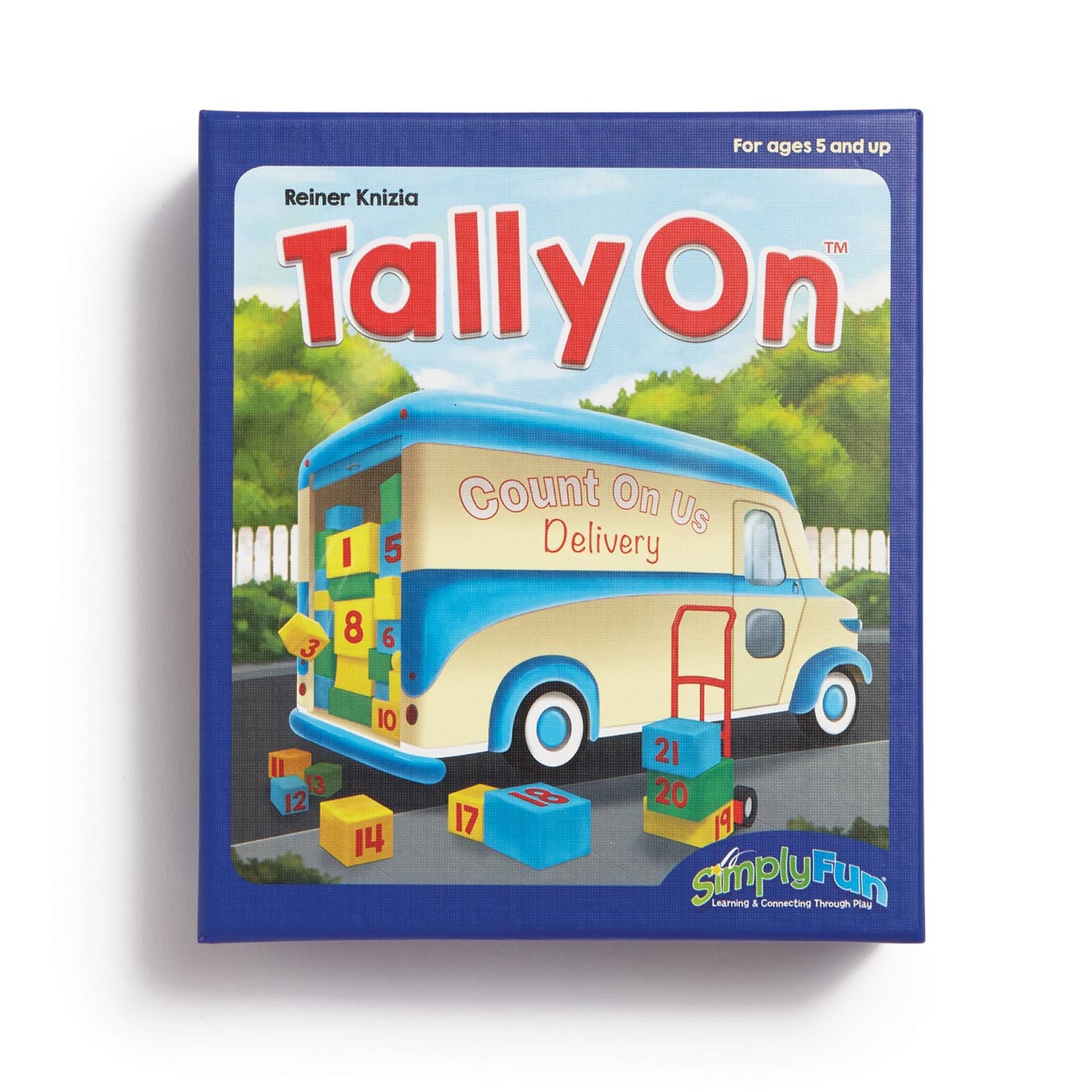
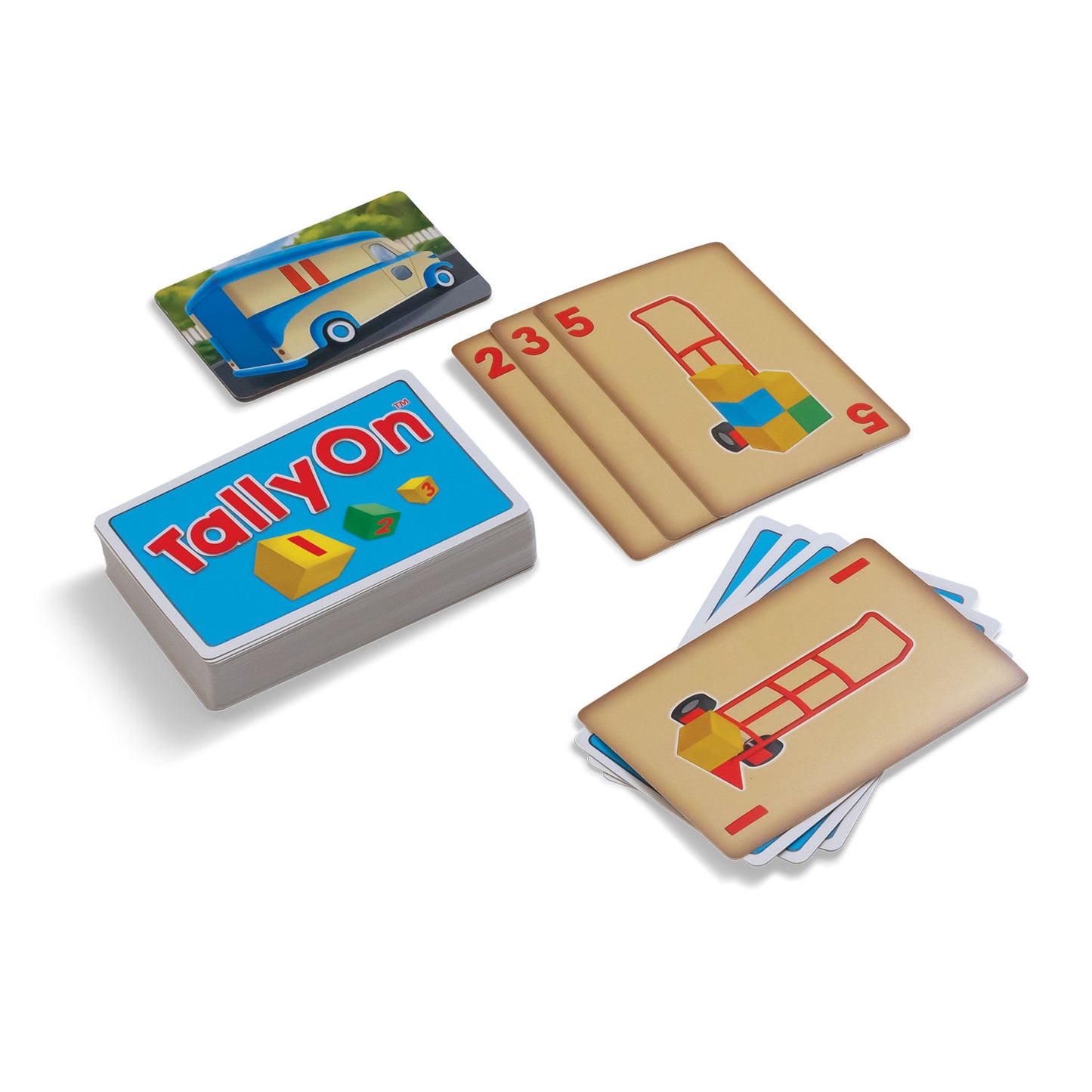
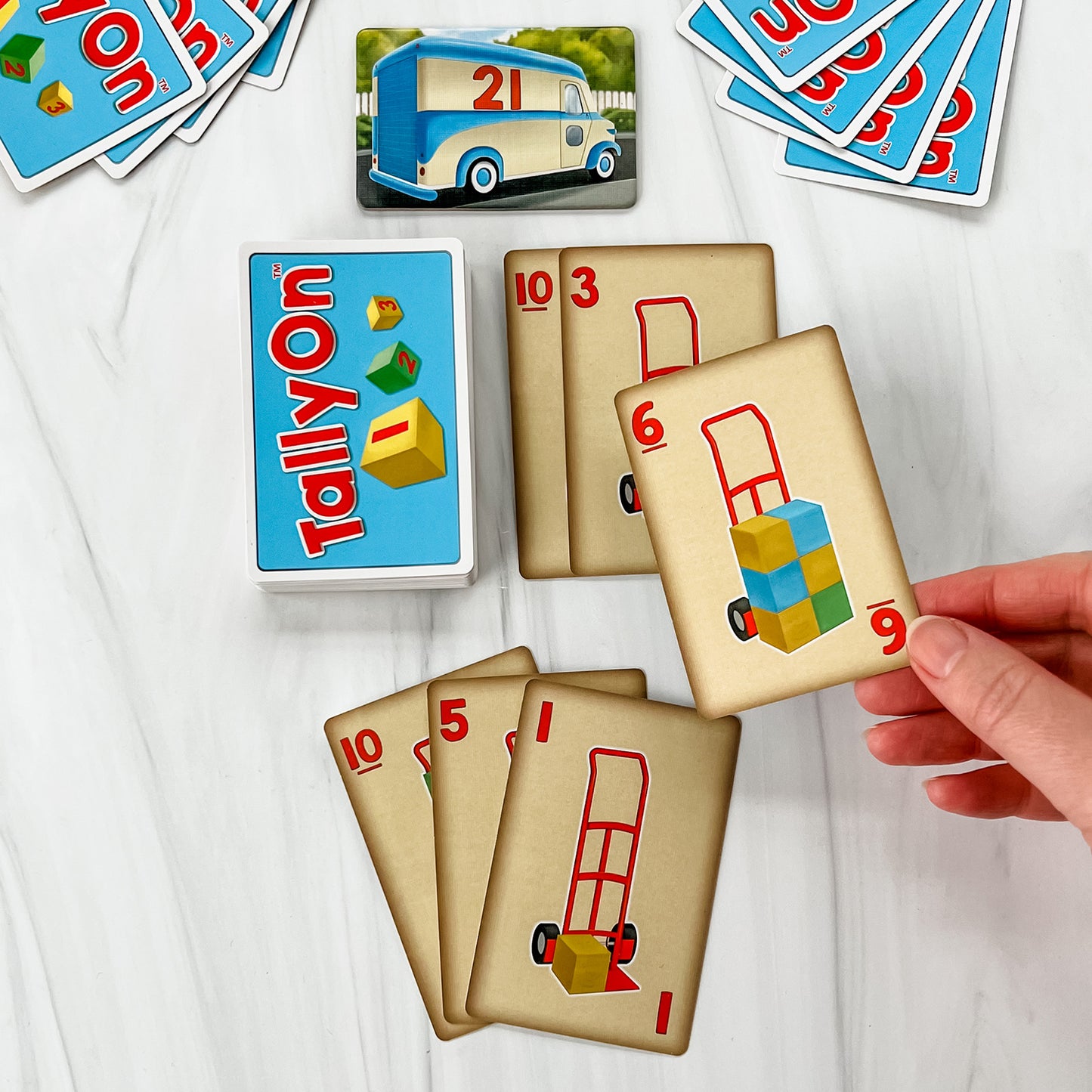
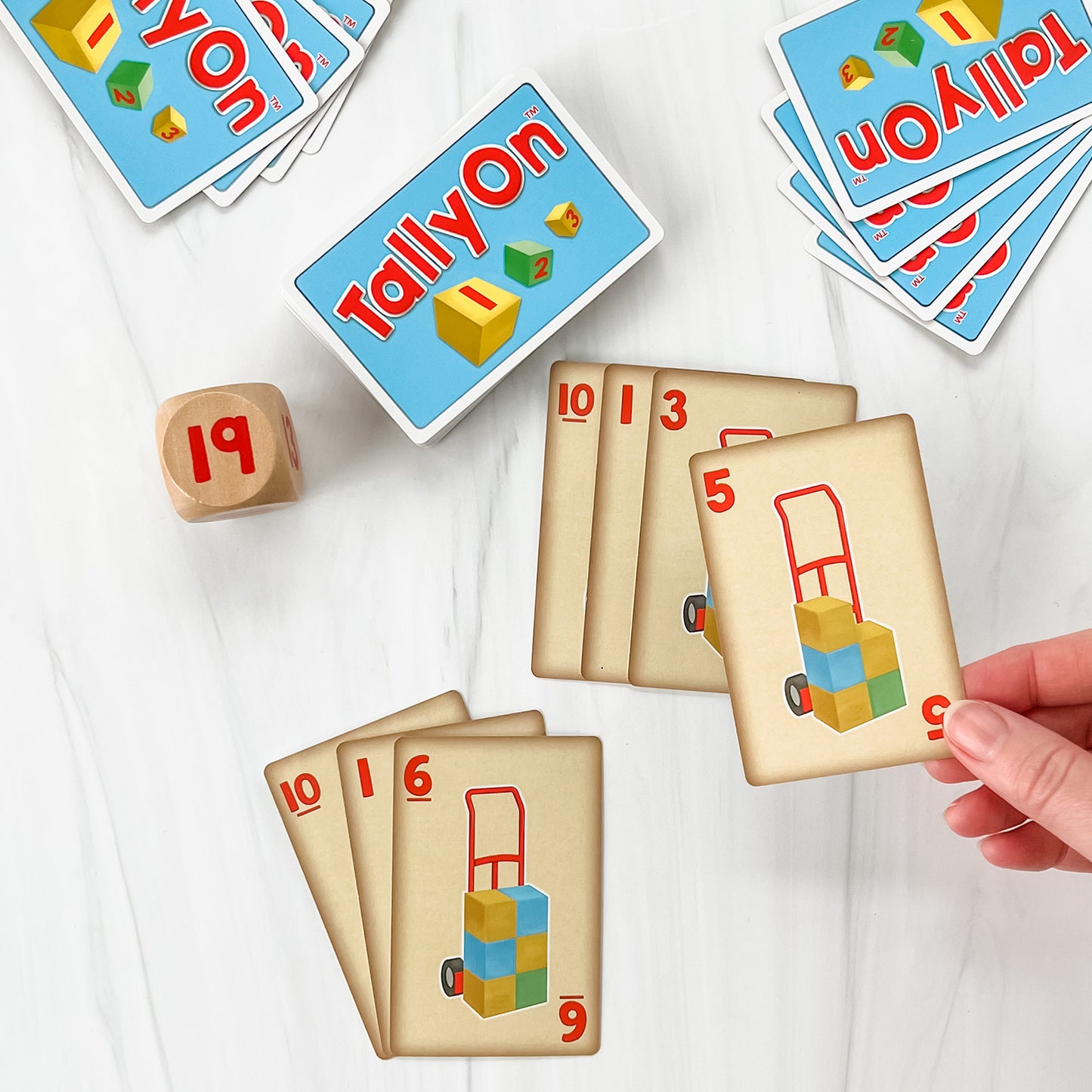
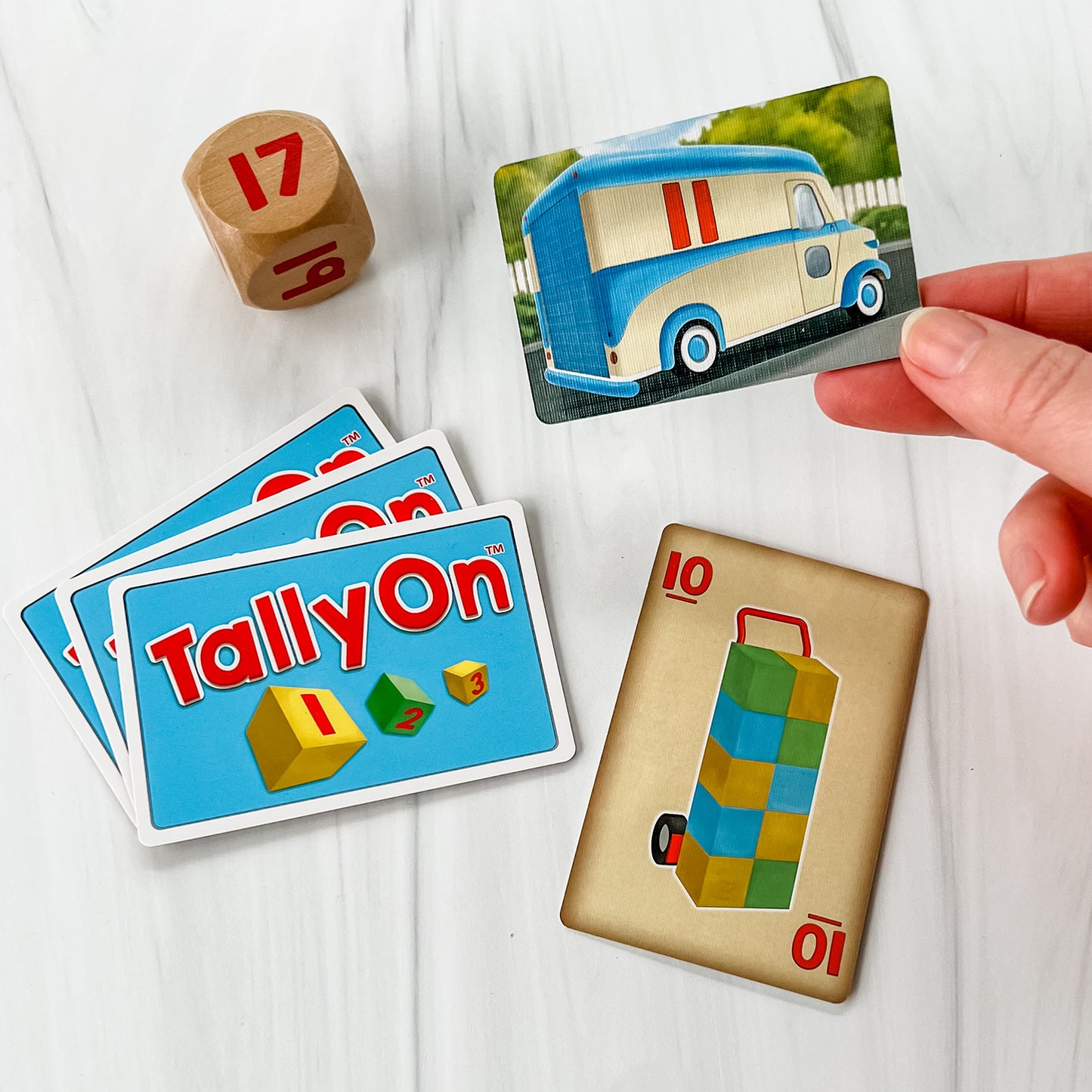
Collapsible content
Today we’re going to count our boxes and fill up our delivery trucks with as we learn to play Simply Fun’s Tally On.
Tally On is a fun math game, great for players ages 5 and up. You can play Tally On with 2 to 4 players.
Each Tally On game box contains:
55 box cards
One truck tile for beginner or intermediate play and one truck die for advanced play.
Tally On players will learn counting skills as they add numbers to the play pile.
They’ll also learn prediction skills, by trying to choose number cards that will get them as close to the goal as possible without going over.
For the standard game, place the truck tile with the number “21” side face up in the center of the play area. This is the number of boxes needed to fill the truck.
Shuffle the box cards and deal four cards to each player. Place the remaining box cards face down in a pile in the center of the play area. This is the draw pile. Leave an open space for a “play pile” to be started by the first player.
Leave the Truck Die in the box, it is not used for standard play.
To start the game, the first player chooses one card from his hand and says the number out loud. This card starts the play pile. Other players will add cards to this pile on their turns.
The goal is to get to the number 21, without going over 21. So, as players add their cards to the play pile, they “count on” from the number on the pile and say the new total out loud.
For example, if the first player plays the number 5, he calls out “five.” The next player may play the number 2, and will call out, “six, seven.” The player after that may play the number 6, and will call out “eight, nine, ten, eleven, twelve, thirteen.” And so on, until one player reaches 21 or cannot play a card without going over.
If a player plays a card that brings the total to exactly 21, he wins that round and may take all the cards in the play pile, saving them in a stack nearby.
As the cards get near 21, a player may get stuck with no cards that can be played without going over 21. In that case, the previous player, who played the last card under 21, wins the play pile since that player played the highest card without going over the limit.
The next player will begin a new round by choosing a card to begin a new play pile.
Each time players play a card, they must draw a replacement card from the draw pile so there are always 4 cards in every hand.
The game continues with players filling trucks with 21 or less boxes and winning play piles until there are no more cards in the draw pile and all players have played all the cards in their hands. Then the game is over.
At the end of the game, all players count the number of cards they won. The numbers on the cards don’t matter. Scores are based on number of cards not totals of numbers on the cards.
The player with the most cards at the end of the game wins!
For an easier game, place the “11” side of the truck card face up, remove all the “10s” from the box cards, and have players count to 11 rather than 21.
For a more advanced game, haul out the Truck die and roll the dice and add to a new number each time a pile is taken.
Any way you play it, you can count on Tally On to be truckloads of fun!


Core Standard*: Math
Math
- Counting and Cardinality
- Know number names and the count sequence. Grade Level K
- Compare Numbers. Grade Level K
- Operations and Algebraic Thinking
- Understand addition as putting together and adding to, and understand subtraction as taking apart and taking from. Grade Level K
- Add and subtract within 20. Grade Level 2nd
- Standards for Mathematical Practice
- Look for and make use of structure. Grade Levels K, 1st.


Determine
What Does Child Do To Use Skill In The Game?
Players need to determine which number combinations are possible and which card to play on their turn.
How Parents Can Assist Learning
Determining number combinations is straight forward in Tally On. However, when children are first learning to play the game, parents can encourage them to "Wait. Look. Think." This will help with impulsivity, considering number combination options and looking closely. Also, using such cues can give children a model for future play in order to think more strategically.
Learning Implications and Educator Support
Determining number combinations is straight forward in Tally On. However, when children are first learning to play the game, educators can encourage them to "Wait. Look. Think." This will help with impulsivity, considering number combination options and looking closely. Also, using such cues can give children a model for future play in order to think more strategically.
Tally On presents an opportunity to learn about adding, counting and counting on. Teachers can integrate Tally On into appropriate activities throughout the day for generalization and practice.
Practice
What Does Child Do To Use Skill In The Game?
As children play Tally On, they are a practicing and improving their adding, counting and counting on skills.
How Parents Can Assist Learning
No special adult support is required. However, as children become proficient at counting up to 21, parents can introduce higher numbers by making their own target tiles that replace the Truck Tile.
Learning Implications and Educator Support
No special adult support is required. However, as children become proficient at counting up to 21, educators can introduce higher numbers by making their own target tiles that replace the Truck Tile. Or, allow a different child at the beginning of each game to declare a number between 21 and 50.
Solve
What Does Child Do To Use Skill In The Game?
Players build solving skills by adapting to the changing total on the play area in order to decide what card to play on their turn.
How Parents Can Assist Learning
Solving simple addition problems is the primary goal of the Tally On, allowing young children to practice and master important addition, counting and counting on skills. Parents can encourage children to explain why they chose a certain card, as well as how they solved the problem. If children produce incorrect mathematical results, parents can work with child to examine the problem to help them learn the correct approach.
Learning Implications and Educator Support
Solving simple addition problems is the primary goal of the Tally On, allowing young children to practice and master important addition, counting and counting on skills. Educators can encourage children to explain why they chose a certain card, as well as how they solved the problem. If children produce incorrect mathematical results, educators can work with child to examine the problem to help them learn the correct procedures.
Demonstrate
What Does Child Do To Use Skill In The Game?
Players demonstrate their counting and adding skills as they count out loud during game play.
How Parents Can Assist Learning
No special adult support is needed, since players are required to demonstrate as part of the game play. If children produce incorrect mathematical results, parents can work with child to examine the problem to help them learn the correct approach.
Learning Implications and Educator Support
No special adult support is needed, since players are required to demonstrate as part of the game play. If children produce incorrect mathematical results, teachers can work with child to examine the problem to help them learn the correct approach.
*Data compiled from CCSSI ELA Standards, WA Science Standards, and Washington Social Studies Standards


Cognitive
Suggestions for How to Modify Play Experience
Make sure the child can count to 11 before starting. If the child cannot count to 11, the game is not appropriate. Use the Truck Tile with the 11 face up. Use pennies as counters to help the child learn to count on. For example, the Draw card is 6. First, ask the child to count the boxes on the card and ask, "What number is next?" Then, have the child create a line of 6 pennies counting them one at time. If the child chooses a 3 card to play, have the child count out the 6 pennies in front of him or her. Then have them look at the number on the play pile and ask again, "What comes after 6? Use the pennies see if you picked the right number. This is 7, 8 and 9 .... count out one penny with each number added." This will demonstrate how to count on in a concrete way, and illustrate that the child chose a number that creates a total of 9.
Use the 11 Truck Tile. If the child has difficulty understanding adding number to 10, remove the 5, 6, and 10. Use the numbers 1, 2, and 3, as these are the first children can visualize mentally without actually physically counting items. As the child begins to understand the counting on process add in the 5 and 6 cards.
Remind the child that the goal is to be the player who has a card that brings the total to 11. As the number on the play pile gets higher, encourage the child to figure out what number is needed to reach the total. Allow children to use their fingers or pennies as a means of determining this.
Communication
Suggestions for How to Modify Play Experience
Children need to verbalize their counting in the game. If they cannot count aloud, let them demonstrate with their fingers or small objects, such as pennies.
Children need to understand the verbal directions to play the game. If the child has difficulty comprehending the verbal directions, physically demonstrate the game process.
Sensorimotor
Suggestions for How to Modify Play Experience
If children have difficulty manipulating all their cards in one hand, use a card holder made from thick paper or thin cardboard folded to make a vertical ledge to hold the cards.s
Social Emotional/Behavioral
Suggestions for How to Modify Play Experience
Children with impulsive behavior may choose a card without thinking. Encourage these children to "count in your head before you choose a card."
Children who become frustrated when they lose may get upset if they never win a pile of cards. Make sure the child understands how to count on by first playing to 11. Caution the child to figure out the best card to play before laying down a card. Have all players describe their thinking when they lay down a card. This will demonstrate how other players determine which card to pick, which in turn can help the child learn how to select the best card on their turn.
Vision
Suggestions for How to Modify Play Experience
Numbers on the cards are not large and the visuals are not high contrast, so children with low vision may have difficulty playing Tally On.
Hearing
Suggestions for How to Modify Play Experience
Although players need to count aloud, players who are deaf and hard of hearing can still play. Allow them to count using sign language. They may not, however, hear if another player is counting on appropriately.
To support learning and communication, have all players count using sign language.
*Data compiled from CCSSI ELA Standards, WA Science Standards, and Washington Social Studies Standards


Autism Strengths & Interests
Short Summary of Strengths & Interests
- Comprehends value of tiles in relation to each other.
- Can use memory of previous plays to inform moves.
- Can use logic and reasoning in decision making.
Is good at matching visual items
This game is not appropriate
Has a good memory for sensory details, including visual, touch, taste and smell
This game is not appropriate
Has a good memory for words, phrases and dialouge
This game is not appropriate
Has a good memory for pictures, numbers and patterns
Is This Game Appropriate? Yes
Description
Players need to remember the counting sequence and the amount represented by each written number symbol.
Likes to put things in order or a sequence
Is This Game Appropriate? Yes
Description
Counting is sequencing numbers by adding one. Therefore, Tally On is great for children who like sequencing, especially if they like numbers or counting.
Learns through visualizing or "replaying" actions in their mind
This game is not appropriate
Likes activities with rules, such as math and phonics
Is This Game Appropriate? Yes
Description
Tally On is based on math and very clear rules. Counting on requires retaining the meaning of the number said and adding one or more, which helps build memory, symbolic understanding and other thinking skills.
Is very concrete and literal
Is This Game Appropriate? Yes
Description
Players need to demonstrate understanding by counting out their answers which helps make Tally On attractive to children who enjoy concrete play experiences.
Learns in small "chunks" (for example, phone numbers are 3 chunks of number xxx-xxx-xxxx that are combined together)
This game is not appropriate
Is good at nonverbal reasoning and logic
Is This Game Appropriate? Yes
Description
Tally On requires simple reasoning by having children use logic to determine which number card to play. The structure of the game does not require verbalizing or talking about your reasoning and analysis.
Likes spatial problem solving
This game is not appropriate
Can read well with good vocabulary, though may not fully comprehend content
This game is not appropriate
Likes to use and has good fine motor skill
This game is not appropriate
Likes established routines or set ways of doing things
This game is not appropriate
Likes manipulating, constructing or building things
This game is not appropriate
Likes to use and has good musical abilities
This game is not appropriate
Likes to use and has good drawing skills
This game is not appropriate
Autism Special Considerations
Appears to ignore other's communication and/or has difficulty giving eye contact to a communication partner
Is This Game Appropriate for Child with Characteristic? Yes
Can Child with Characteristic Play Game w/o Modification? Yes
Strategies for Developing Compensatory Skills:
Children who don't like to look at other players can just look at the cards.
Has difficulty understanding complex verbal directions
Is This Game Appropriate for Child with Characteristic? Yes
Can Child with Characteristic Play Game w/o Modification? Yes
Strategies for Developing Compensatory Skills:
The directions are not very difficult. If children need extra support, an adult or other child can demonstrate the instructions as they are read or said aloud.
Uses vocabulary inaccurately or demonstrates echolalia (repeating another's speech)
Is This Game Appropriate for Child with Characteristic? Yes
Can Child with Characteristic Play Game w/o Modification? No
Strategies for Developing Compensatory Skills:
Children who are echolalia may be distracting to other players who are trying to count out their answer. Use a hand sign or gesture, such as the stop hand signal, or tapping the table in front of the child to indicate stop talking. Say, "Time to listen."
Gets stuck repeating a verbal topic or physical actions and/or has difficulty attending to others' actions or topic.
Is This Game Appropriate for Child with Characteristic? Yes
Can Child with Characteristic Play Game w/o Modification? No
Strategies for Developing Compensatory Skills:
Children with autism often have repetitive behaviors. If other players are bothered by these behaviors, provide a fidget toy for the child to play with between turns. Alternatively, in between games allow the child to walk around or do something active. This often helps increase attention afterwards.
Has difficulty producing speech/communication
Is This Game Appropriate for Child with Characteristic? Yes
Can Child with Characteristic Play Game w/o Modification? No
Strategies for Developing Compensatory Skills:
Make small cards with one number on each to lay out in front of the child. Allow the child to demonstrate counting on by pointing to the numbers after placing his card on the play pile.
Has difficulty sequencing multi-step actions and/or doing complex abstract tasks
Is This Game Appropriate for Child with Characteristic? Yes
Can Child with Characteristic Play Game w/o Modification? Yes
Strategies for Developing Compensatory Skills:
No multistep actions are required.
Demonstrates difficulty initiating and maintaining social interactions
Is This Game Appropriate for Child with Characteristic? Yes
Can Child with Characteristic Play Game w/o Modification? Yes
Strategies for Developing Compensatory Skills:
There are low social requirements other than players being patient while others take turns.
Acts out or demonstrates avoidance behaviors when frustrated, overwhelmed, or needs more sensory input.
Is This Game Appropriate for Child with Characteristic? Yes
Can Child with Characteristic Play Game w/o Modification? No
Strategies for Developing Compensatory Skills:
If the child demonstrates frustrations, provide a fidget toy for the child to play with between turns. In between games allow the child to walk around or do something active. This often helps increase attention afterwards. Between games allow the child to run around or do something active. This often helps increase attention afterwards.
Children who like numbers should find Tally On a fun game.
Has short attention span for non-preferred activities
Is This Game Appropriate for Child with Characteristic? No
Can Child with Characteristic Play Game w/o Modification? No
Strategies for Developing Compensatory Skills:
If numbers are not of interest to the child, this game will likely not be fun for the child.
Needs sameness or consistent routines and/or has difficulty with transitions from one activity to another
Is This Game Appropriate for Child with Characteristic? Yes
Can Child with Characteristic Play Game w/o Modification? Yes
Strategies for Developing Compensatory Skills:
The game is consistent and played the same way each time.
Transition to the game when you notice the child is talking about numbers or is counting aloud.
Has difficulty understanding others' feelings, intentions, and the reasons for others' actions.
Is This Game Appropriate for Child with Characteristic? Yes
Can Child with Characteristic Play Game w/o Modification? Yes
Strategies for Developing Compensatory Skills:
Children do not have to understand others thinking or feeling to play the game well.
*Data compiled from CCSSI ELA Standards, WA Science Standards, and Washington Social Studies Standards


Extra Ways to Play the Game
If you have blocks or other fun things to stack, build a structure next to the discarded pile with the same number of items as on the cards laid down.
Materials Needed
Blocks, plastic plates or bowls, or other safe stackable objects.
Developmental Benefits
Using concrete objects makes the counting more meaningful and shows that many objects can be manipulated to equal the same number.
Extra Ways to Play the Game
If players cannot play a card, but can match a card to one on the top of the pile, they can take the matching cards and put them into the discard pile. After removing the card, the players turn ends. This subtracts a number from the prior total and gives both players a new options.
Materials Needed
No additional materials needed.
Developmental Benefits
This option adds a new math operation (subtraction) to the game. The child can determine the new total number after subtracting the number on the discarded card from the total in the pile. This also adds a new element of strategy to the game, as players now can change the path of the round.
Extra Ways to Play the Game
When playing the 21 truck, roll the die for each round of the game. The first player then chooses either the total number on the truck or the number on the die.
Materials Needed
No additional materials needed.
Developmental Benefits
This alternative gives players the option for choosing lower or higher numbers, for lesser or greater challenge. Children who are not as confident or skilled with numbers may prefer the smaller numbers.
Extra Ways to Play the Game
Roll the die and add the number on the die to the 21 on the truck tile. This becomes the new target total.
Materials Needed
No additional materials needed.
Developmental Benefits
This option will provide a much larger target number, requiring more addition to get to the total. This is good for children who have already mastered the counting on skills to 11 and 21.
*Data compiled from CCSSI ELA Standards, WA Science Standards, and Washington Social Studies Standards
- Choosing a selection results in a full page refresh.
- Opens in a new window.






